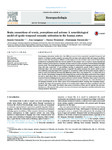Brain connections of words, perceptions and actions: A neurobiological model of spatio-temporal semantic activation in the human cortex
| dc.contributor.author | Tomasello, R | |
| dc.contributor.author | Garagnani, M | |
| dc.contributor.author | Wennekers, Thomas | |
| dc.contributor.author | Pulvermüller, F | |
| dc.date.accessioned | 2016-11-09T11:40:33Z | |
| dc.date.accessioned | 2017-08-07T09:55:57Z | |
| dc.date.available | 2016-11-09T11:40:33Z | |
| dc.date.available | 2017-08-07T09:55:57Z | |
| dc.date.issued | 2016-11-07 | |
| dc.identifier.issn | 0028-3932 | |
| dc.identifier.issn | 1873-3514 | |
| dc.identifier.uri | http://hdl.handle.net/10026.1/9676 | |
| dc.description.abstract |
Neuroimaging and patient studies show that different areas of cortex respectively specialize for general and selective, or category-specific, semantic processing. Why are there both semantic hubs and category-specificity, and how come that they emerge in different cortical regions? Can the activation time-course of these areas be predicted and explained by brain-like network models? In this present work, we extend a neurocomputational model of human cortical function to simulate the time-course of cortical processes of understanding meaningful concrete words. The model implements frontal and temporal cortical areas for language, perception, and action along with their connectivity. It uses Hebbian learning to semantically ground words in aspects of their referential object- and action-related meaning. Compared with earlier proposals, the present model incorporates additional neuroanatomical links supported by connectivity studies and downscaled synaptic weights in order to control for functional between-area differences purely due to the number of in- or output links of an area. We show that learning of semantic relationships between words and the objects and actions these symbols are used to speak about, leads to the formation of distributed circuits, which all include neuronal material in connector hub areas bridging between sensory and motor cortical systems. Therefore, these connector hub areas acquire a role as semantic hubs. By differentially reaching into motor or visual areas, the cortical distributions of the emergent 'semantic circuits' reflect aspects of the represented symbols' meaning, thus explaining category-specificity. The improved connectivity structure of our model entails a degree of category-specificity even in the 'semantic hubs' of the model. The relative time-course of activation of these areas is typically fast and near-simultaneous, with semantic hubs central to the network structure activating before modality-preferential areas carrying semantic information. | |
| dc.format.extent | 111-129 | |
| dc.format.medium | Print-Electronic | |
| dc.language | en | |
| dc.language.iso | en | |
| dc.publisher | Elsevier BV | |
| dc.relation.replaces | http://hdl.handle.net/10026.1/6694 | |
| dc.relation.replaces | 10026.1/6694 | |
| dc.subject | Word acquisition | |
| dc.subject | Semantic grounding | |
| dc.subject | Hebbian cell assembly | |
| dc.subject | Biologically inspired neural network | |
| dc.subject | Word recognition EEG-MEG responses | |
| dc.subject | Cortical connectivity | |
| dc.title | Brain connections of words, perceptions and actions: A neurobiological model of spatio-temporal semantic activation in the human cortex | |
| dc.type | journal-article | |
| dc.type | Journal Article | |
| dc.type | Research Support, Non-U.S. Gov't | |
| plymouth.author-url | https://www.webofscience.com/api/gateway?GWVersion=2&SrcApp=PARTNER_APP&SrcAuth=LinksAMR&KeyUT=WOS:000401202100011&DestLinkType=FullRecord&DestApp=ALL_WOS&UsrCustomerID=11bb513d99f797142bcfeffcc58ea008 | |
| plymouth.volume | 98 | |
| plymouth.publication-status | Published | |
| plymouth.journal | Neuropsychologia | |
| dc.identifier.doi | 10.1016/j.neuropsychologia.2016.07.004 | |
| plymouth.organisational-group | /Plymouth | |
| plymouth.organisational-group | /Plymouth/Admin Group - REF | |
| plymouth.organisational-group | /Plymouth/Admin Group - REF/REF Admin Group - FoSE | |
| plymouth.organisational-group | /Plymouth/Faculty of Science and Engineering | |
| plymouth.organisational-group | /Plymouth/Faculty of Science and Engineering/School of Engineering, Computing and Mathematics | |
| plymouth.organisational-group | /Plymouth/REF 2021 Researchers by UoA | |
| plymouth.organisational-group | /Plymouth/REF 2021 Researchers by UoA/UoA11 Computer Science and Informatics | |
| plymouth.organisational-group | /Plymouth/Users by role | |
| plymouth.organisational-group | /Plymouth/Users by role/Academics | |
| dc.publisher.place | England | |
| dcterms.dateAccepted | 2016-07-03 | |
| dc.identifier.eissn | 1873-3514 | |
| dc.rights.embargoperiod | No embargo | |
| rioxxterms.funder | EPSRC | |
| rioxxterms.identifier.project | BABEL | |
| rioxxterms.versionofrecord | 10.1016/j.neuropsychologia.2016.07.004 | |
| rioxxterms.licenseref.uri | http://www.rioxx.net/licenses/all-rights-reserved | |
| rioxxterms.licenseref.startdate | 2016-11-07 | |
| rioxxterms.type | Journal Article/Review | |
| plymouth.funder | BABEL::EPSRC | |
| plymouth.oa-location | http://www.sciencedirect.com/science/article/pii/S0028393216302421 |


